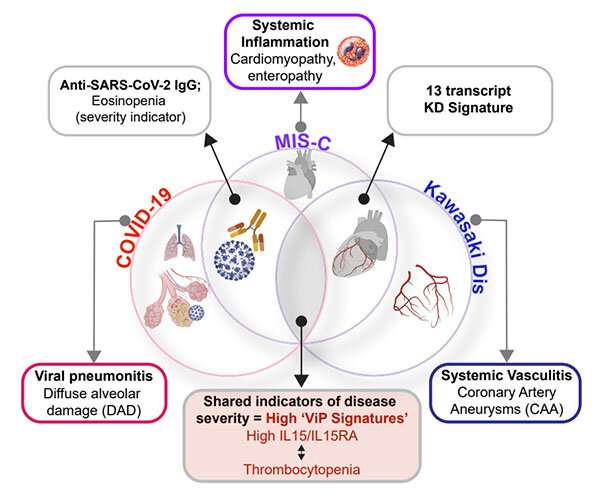Science, Art, Litt, Science based Art & Science Communication
 UC San Diego researchers summarize the similarities and differences between COVID-19, MIS-C and Kawasaki disease, three conditions unified by the same immune-associated gene signature. Credit: UC San Diego Health Sciences
UC San Diego researchers summarize the similarities and differences between COVID-19, MIS-C and Kawasaki disease, three conditions unified by the same immune-associated gene signature. Credit: UC San Diego Health SciencesThe emergence of COVID-19 had doctors racing to define and treat the new disease, but they soon discovered it was not the only novel illness caused by SARS-CoV-2. A subset of children infected by the virus also experienced abdominal pain, headaches, rashes and vomiting. This new set of symptoms was labeled multisystem inflammatory syndrome in children (MIS-C) and had many of its pediatric patients requiring intensive care.
As MIS-C rates rose, physicians began to note its similarities to a pre-pandemic illness, Kawasaki disease (KD), which has puzzled pediatricians for more than 50 years. MIS-C and KD share many symptoms, including fever, rash and bloodshot eyes, though KD can also lead to coronary artery aneurysms and heart attack. Unlike MIS-C, which is associated with a specific virus, KD may be triggered by a variety of infections and environmental stimuli.
To better understand how these inflammatory syndromes compare and contrast, researchers collected blood and tissue samples from MIS-C and KD patients. Using artificial intelligence tools, they analyzed patterns of gene expression in both conditions and compared them to gene expression markers of COVID-19.
The study, publishing May 16, 2022 in Nature Communications, reveals that MIS-C and KD are on the same immune response continuum as COVID-19, with MIS-C being a more severe version of the response than KD. Despite these underlying similarities, the conditions do diverge in several laboratory and clinical parameters. Authors said the findings could improve disease diagnosis, monitoring and treatment in pediatric patients.
We want our immune system to protect us from harmful stimuli, but some children are genetically predisposed to respond more intensely, leading to inflammation and unwanted symptoms across the body. The sooner we can identify and understand the child's inflammatory condition, the better we can tailor our delivery of life-saving support.
The research team previously identified a set of 166 genes expressed in viral respiratory diseases, including COVID-19, a subset of which also corresponded to disease severity. Researchers found that this same "gene signature" also applied to both MIS-C and KD, suggesting the conditions all stem from a similar underlying mechanism, which involves the rapid release of IL15/IL15RA cytokines.
The team then looked at a separate set of 13 genes used to identify KD, and found that a computer program trained to look for this genetic signature could not tell the KD and MIS-C samples apart.
Researchers were not expecting that. So they analyzed MIS-C and KD through the lens of two distinct gene signatures, and both experiments told them these diseases are closely related.
The two gene signatures likely represent different parts of the same broader immune response.
While the study provides a new unifying framework for these diseases, it also identifies a few subtle differences. For example, MIS-C patients had lower blood platelet and eosinophil counts, two features that can be measured from routine blood tests. And, while many serum cytokines were similarly elevated in both conditions, a select few were more elevated in MIS-C than in KD samples.
The researchers think their findings have a high potential to impact clinical trial planning immediately, and also shape clinical guidelines and patient care down the line.
Nature Communications (2022). www.nature.com/articles/s41467-022-30357-w
Views: 64
Replies to This Discussion
-
22
-
© 2025 Created by Dr. Krishna Kumari Challa.
Powered by
![]()